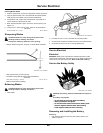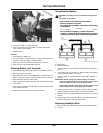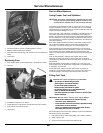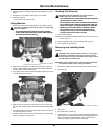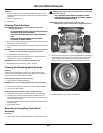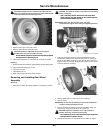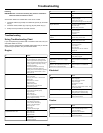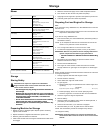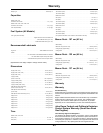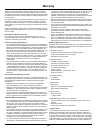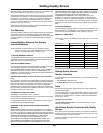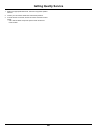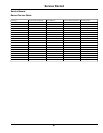
Mower
IF CHECK
Discharge Chute Plugged Travel speed too fast.
Grass too long.
Grass too wet.
Engine rpm not at wide open throttle.
Restricted air ow.
Belt installed incorrectly.
Patches Of Grass Uncut Travel speed too fast.
Engine rpm not at wide open throttle.
Mower deck needs cleaning.
Belt Slipping Debris in sheaves.
Worn belt.
Belt tension is incorrect.
Too Much Vibration Debris on mower deck or in sheaves.
Damaged drive belt.
Damaged sheaves or sheaves out of
alignment.
Blades out of balance.
Blades Scalping Grass Cutting too low.
Mower wheels not adjusted correctly.
Turning speed too fast.
Ridges in terrain.
Rough or uneven terrain.
Low tire pressure.
Mower Loads Down Tractor Engine rpm too low.
Travel speed too fast.
Debris wrapped around mower spindles.
Uneven Cut Mower deck not leveled properly.
Travel speed too fast.
Blades dull.
Mower wheels not adjusted correctly.
Tire pressure unequal.
Mower (Or Other Attachment) Stops When
Vehicle Is Operated in REVERSE
Normal condition. (See Using Reverse
Implement Option in the OPERATING
section.)
Storage
Storing Safety
CAUTION: Fuel vapors are explosive and ammable.
Engine exhaust fumes contain carbon monoxide and can
cause serious illness or death:
• RRuunn tthhee eennggiinnee oonnllyy lloonngg eennoouugghhttoo mmoovvee tthhee mmaacchhiinnee ttoo oorr
ffrroomm ssttoorraaggee..
• MMaacchhiinnee rreess aanndd ssttrruuccttuurree rreess ccaann ooccccuurr iiff aa mmaacchhiinnee iiss
ssttoorreedd bbeeffoorree aalllloowwiinngg iitt ttoo ccooooll,, oorr iiff ddeebbrriiss iiss nnoott rreemmoovveedd
ffrroomm aarroouunndd tthhee eennggiinnee aanndd mmuuffeerr,, oorr iiff ssttoorreedd nneeaarr
ccoommbbuussttiibbllee mmaatteerriiaallss..
• DDoo nnoott ssttoorree vveehhiiccllee wwiitthh ffuueell iinn tthhee ttaannkk iinnssiiddee aa bbuuiillddiinngg
wwhheerree ffuummeess mmaayy rreeaacchh aann ooppeenn aammee oorr ssppaarrkk..
• AAllllooww tthhee eennggiinnee ttoo ccooooll bbeeffoorree ssttoorriinngg tthhee mmaacchhiinnee iinn aannyy
eenncclloossuurree..
Preparing Machine for Storage
1. Repair any worn or damaged parts. Replace parts if necessary.
Tighten loose hardware.
2. Repair scratched or chipped metal surfaces to prevent rust.
3. Remove grass and debris from machine.
4. Clean under the deck and remove grass and debris from inside chute
and bagger.
5. Wash the machine and apply wax to metal and plastic surfaces.
6. Run machine for ve minutes to dry belts and pulleys.
7. Apply light coat of engine oil to pivot and wear points to prevent rust.
8. Lubricate grease points and check tire pressure.
Preparing Fuel and Engine For Storage
Fuel:
If you have been using “Stabilized Fuel,” add stabilized fuel to tank until
the tank is full.
NOTE: Filling the fuel tank reduces the amount of air in the fuel tank and
helps reduce deterioration of fuel.
If you are not using “Stabilized Fuel:”
1. Park machine safely in a well-ventilated area. (See Parking Safely in
the SAFETY section.)
NOTE: Try to anticipate the last time the machine will be used for the
season so very little fuel is left in the fuel tank.
2. Turn on engine and allow to run until it runs out of fuel.
3. For machines equipped with key switch, turn key to off position.
IMPORTANT: Stale fuel can produce varnish and plug carburetor or
injector components and affect engine performance.
• AAdddd ffuueell ccoonnddiittiioonneerr oorr ssttaabbiilliizzeerr ttoo ffrreesshh ffuueell bbeeffoorree lllliinngg
ttaannkk..
4. Mix fresh fuel and fuel stabilizer in separate container. Follow
stabilizer instructions for mixing.
5. Fill fuel tank with stabilized fuel.
6. Run engine for a few minutes to allow fuel mixture to circulate
through carburetor on gas engine or fuel injectors on diesel engine.
Engine:
Engine storage procedure should be used when vehicle is not to be used
for longer than 60 days.
1. Change engine oil and lter while engine is warm.
2. Service air lter if necessary.
3. Clean debris from engine air intake screen.
4. On gas engines:
a. Remove spark plugs. Put specied amount of clean engine oil in
cylinder(s).
Specication
Engine Oil in Cylinder - Storage — Quantity . . . . . . . . . . . . . . . . . . . . .30 mL (1 oz)
b. Install spark plugs, but do not connect spark plug wires.
c. Crank the engine ve or six times to allow oil to be distributed.
5. Clean the engine and engine compartment.
6. Remove battery.
7. Clean the battery and battery posts. Check the electrolyte level, if
your battery is not maintenance free.
8. Close fuel shut-off valve, if your machine is equipped.
9. Store the battery in a cool, dry place where it will not freeze.
NOTE: The stored battery should be recharged every 90 days.
10. Charge the battery.
IMPORTANT: Prolonged exposure to sunlight could damage the
hood surface. Store machine inside or use a cover if stored
outside.
Storage
51




